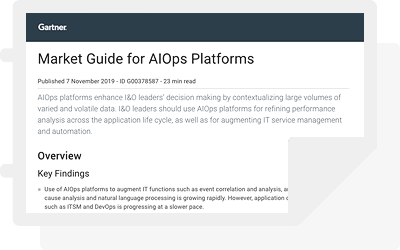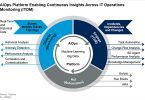It’s certainly an interesting time to be in IT Operations, being at the forefront as they are of ‘always on’ customer experience expectations. The success of digital transformation initiatives increasingly relies on frictionless IT Operations processes which positions these teams in a powerful and important role within organizations. With these opportunities comes many challenges. In addition to managing performance and availability across complex, hybrid environments, new challenges for monitoring and event management processes are emerging including:
- Huge increases in the volumes of operational data now beyond human scale to manage
- Observability of new cloud native container-based applications and microservices
- DevOps initiatives driving the need to monitor and manage many more apps on faster release cycles
We recently delivered a webinar with Forrester Consulting, ‘The IT Operations Balancing Act – Deliver Velocity with Quality’, during which we asked webinar attendees to respond to several polls to gauge how IT Operations leaders and teams are dealing with these challenges, how strategies are evolving and the rate of AIOps adoption. The results of these polls serve as an interesting snapshot of aspects of Infrastructure & Operations (I&O) evolution and maturity.
Poll 1: ITOps challenges
In the first poll, we asked about what was behind the major challenges they are facing and the opposing demands of velocity and quality in IT Operations.
Poll 1: What factors are challenging IT Ops processes and driving the need to balance velocity with quality in your organization? (Choose any answer that is relevant – multiple answers if required.)
Results:
| 1. Digital transformation initiatives | 44% |
| 2. DevOps processes | 34% |
| 3. Adoption of new technologies (cloud, containers, microservices, cloud native apps) | 73% |
| 4. Increased volumes of IT Operations data | 51% |
The adoption of new technologies is the biggest challenge according to respondents which is not surprising given the large increases we are seeing in containerized applications being run in production. According to Gartner, by 2023, more than 70% of global organizations will be running more than two containerized applications in production, up from less than 20% in 2019. These cloud-native apps and containers are creating monitoring visibility gaps that challenge traditional monitoring practices. As discussed in the webinar, a holistic approach to monitoring and event management across traditional on-prem and new cloud and container environments with consolidation of all IT operations data in a single, AI driven solution is key to overcoming this challenge.
Poll 2: Siloed vs holistic I&O processes
The second poll we asked our webinar audience was related to how they are transitioning from a siloed approach to I&O processes with, for example, multiple monitoring tools for different technologies and little integration between ITOM and other IT processes to a more integrated and holistic approach.
As IT Operations teams are dealing with more complex environments and new technologies like containers and microservices, the disadvantages of a siloed approach to monitoring and event management are becoming ever more apparent. During the webinar, Rich Lane from Forrester pointed out some of the key challenges that arise from this approach:
- Too many voices looking at disparate sets of siloed data
- No real way to correlate events, logs, etc. to call volume
- No clear sense of incident ownership
- Unnecessarily long MTTR
Poll 2: Do you consider your I&O processes to be siloed or holistic and integrated or in transition between the two?
Results:
| 1. Silo’d | 41% |
| 2. Holistic and Integrated | 10% |
| 3. In transition | 48% |
The poll results show that this is very much an issue within IT Ops teams today although it is encouraging that almost 50% of respondents are ‘in transition’ and in the process of breaking down the silos both within IT Ops and across other IT disciplines such as ITSM. Indeed, AIOps can be a key facilitator of this transition by unifying all business data under one umbrella and pairing intelligence with automation to bridge processes, drive automation and increase visibility.
Poll 3: AIOps adoption
This brings us to the results of our next poll of the webinar which was focused on AIOps adoption. Having asked this exact same question in an AIOps webinar we delivered back in June 2019, we can compare the evolution of AIOps adoption across 9 months.
Poll 3: At what stage of AIOps adoption is your IT Ops team?
Results:
| Feb 2020 | June 2019 | |
| Exploring options & use cases | 70% | 62% |
| Planning to deploy | 21% | 15% |
| Actively deploying | 9% | 19% |
| Fully implemented AIOps strategy | 0% | 4% |
So, the categories of exploring options and planning for AIOps have gone up between June 2019 and February 2020 which we would expect as awareness of the benefits has grown. Conversely, the categories of actively deploying and having fully implemented AIOps have gone down. There was general agreement from the discussion and comments on the webinar that this reflects a more realistic approach to AIOps today than many IT Ops teams had 9 months ago. There is now broad recognition of the potential immense value of a successful AIOps strategy and many organizations are therefore taking a more planful and considered approach to implementing AIOps use cases.
Poll 4: I&O maturity
Our last poll was focused on transformation and maturity across Infrastructure & Operations organizations and processes. As IT Operations struggles to achieve that balancing act of maintaining performance while moving at the speed required by digital innovation, what are the key ways they are transforming and moving along the I&O maturity curve?
Poll 4: What is the level of I&O maturity in your organization
Results:
| 1. Low level maturity – manual processes, legacy systems, no AI/ML, Dev and Ops separated, silos of monitoring. | 50% |
| 2. Medium level maturity – some automated processes, applying AI/ML for limited use cases, supporting DevOps initiatives | 47% |
| 3. High Level Maturity – Single pane of glass, consolidated monitoring, fully implemented AIOps use cases, automated event resolution | 3% |
Our webinar respondents took a very realistic approach to this poll as well with 50% recognizing they are still at low level maturity and a slightly smaller number at medium level with only 3% at high level. This is reflective of the market although the fact that many realize they are at these low and medium maturity levels will no doubt foreshadow significant change and innovation in IT Operations processes in the coming years.
BMC supports the State of IT Operations
Also covered in the webinar was the recent release of BMC Helix Monitor which has been developed to help IT Ops teams undertake the required transformation along the maturity curve from manual, siloed processes to AI and Machine Learning driven processes that are automated, integrated and provide deep visibility via a single view into performance across hybrid, complex environments.
BMC Helix Monitor is part of the BMC Helix end-to-end service and operations SaaS platform which unites Discovery, Monitoring, Service Management, Optimization and Remediation. BMC Helix Monitor combines broad capabilities across monitoring and event management with a cloud native containerized microservices architecture that enables fast deployment and upgrades, elastic scalability, enterprise grade high availability and performance along with the reduced infrastructure costs that come with a SaaS deployment model. The solution features a modern user experience and automated workflows to streamline monitoring and event management processes and enables large scale ingestion of events and metrics for AIOps use cases.







